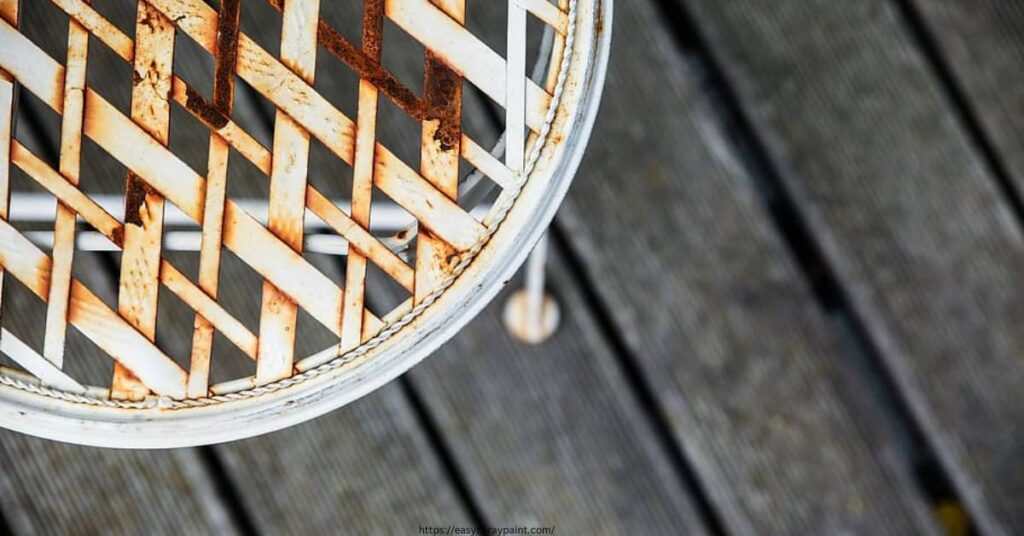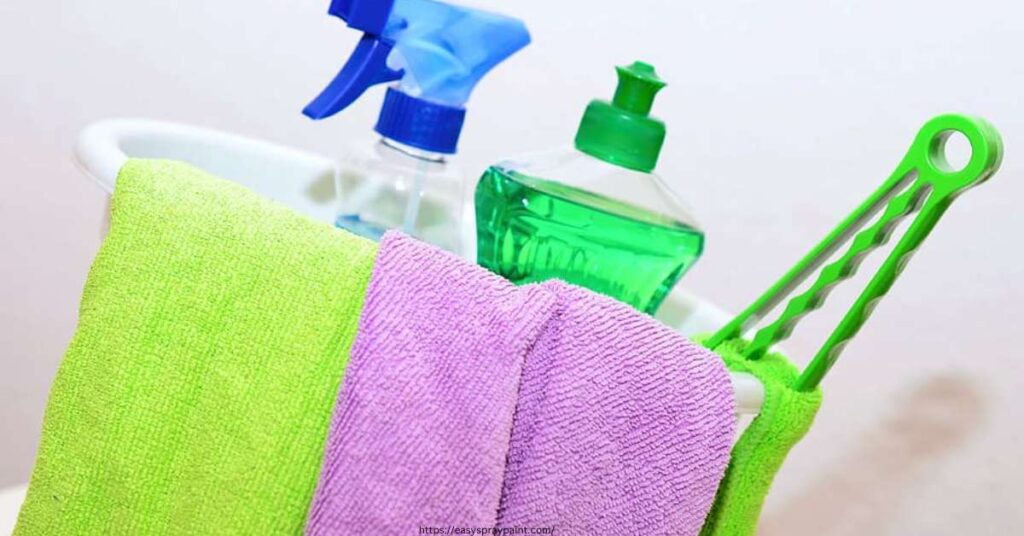What Should I Use To Clean A Painted Metal Surface Before Spray Painting: To clean a painted metal surface before spray painting, use a degreaser or denatured alcohol to remove any dust or oil. Lightly sand if previously painted.
I had this old metal chair that looked really dull. I wanted to repaint it, but the paint wouldn’t stick right. Then I figured out the problem! I needed to clean the chair first.
So, I used some degreaser and a bit of sandpaper to scrub off the old paint and grime. It worked like magic! The new spray paint stuck perfectly and the chair looks awesome now.
Tip: Always clean and sand your metal stuff before painting. It helps the paint stick better and makes your project look super cool!
Curious about the best ways to prepare metal for a fresh coat of paint? Keep reading to learn simple yet effective tips for ensuring your spray paint job looks professional and lasts longer!

Why is proper surface preparation crucial before spray painting?
Proper surface preparation before spray painting is essential for several reasons.
- It ensures the paint adheres well to the surface. If the surface is dirty, oily, or has loose paint, the new paint won’t stick properly, leading to peeling and chipping.
- Cleaning and sanding the surface create a smooth base, which is key for a professional-looking finish. Without this, the paint might look uneven or bumpy. Also, removing rust and old paint prevents future corrosion under the new paint layer.
- Good preparation extends the life of the paint job, making it more durable and resistant to wear and tear. This step is crucial for achieving a long-lasting, high-quality finish on any metal surface.
Choosing the Right Cleaning Materials For A Painted Metal Surface
Choosing the right cleaning materials for a painted metal surface is a crucial step in ensuring a successful spray paint job. Here’s a list of recommended materials, followed by an explanatory paragraph:
- Degreaser or Mineral Spirits: Ideal for removing grease, oil, and other contaminants.
- Mild Detergent: Useful for general cleaning to remove dirt and debris.
- Sandpaper (Fine Grit): Helps in smoothing the surface and removing loose paint.
- Wire Brush or Steel Wool: Effective for scrubbing off rust and tough grime.
- Tack Cloth: For picking up residual dust after sanding.
- Rust Remover (if needed): Specifically for surfaces with significant rust.
What are the various cleaning agents suitable for painted metal surfaces?
Various cleaning agents suitable for painted metal surfaces include degreasers for removing oil and grease, mineral spirits for tough grime, mild detergents for general cleaning, and vinegar for rust removal.

Wire brushes and sandpaper can be used for physical removal of rust and old paint. Tack cloths are excellent for picking up residual dust after sanding. Each agent serves a specific purpose, ensuring the metal is properly prepped and clean before applying spray paint.
What are the pros and cons of each cleaning agent, considering factors like residue, toxicity, and effectiveness?
| Cleaning Agent | Pros | Cons |
|---|---|---|
| Degreaser | Highly effective on oil/grease; strong action | Can be toxic; requires good ventilation |
| Mineral Spirits | Effective on oil/grease; evaporates quickly | Flammable; emits strong fumes |
| Mild Detergent | Non-toxic; gentle on surfaces | Less effective on heavy grease/oil |
| Wire Brush | Physically removes rust and flaking paint | Can scratch surface; manual effort required |
| Vinegar | Eco-friendly; good for rust removal | Less effective on grease; can leave residue |
| Tack Cloth | Excellent for dust removal | Can leave sticky residue if used excessively |
| Sandpaper | Smoothens surface for better paint adhesion | Manual effort; dust creation |
| Rust Remover | Specifically targets rust | Can be corrosive; requires careful handling |
Step-by-Step Guide to Cleaning Painted Metal Surfaces
Cleaning a painted metal surface before spray painting is a straightforward process. Here’s a step-by-step guide to ensure you do it correctly:
- Wipe Down the Surface: Begin by wiping the metal surface with a clean, dry cloth to remove loose dirt and dust.
- Apply Degreaser or Mineral Spirits: Use a degreaser or mineral spirits to remove any oily or greasy residues. Apply it with a cloth and rub gently on the surface.
- Wash with Mild Detergent: Mix a mild detergent with water and use a sponge or cloth to clean the surface. This step helps remove any remaining dirt and grime.
- Rinse with Water: After washing, rinse the surface thoroughly with clean water to remove any soap residue.
- Dry the Surface: Use a clean, dry cloth to wipe down the surface, ensuring it’s completely dry.
- Sand the Surface: Lightly sand the surface with fine-grit sandpaper. This helps to create a smooth base and remove any loose or flaking paint.
- Clean with Tack Cloth: After sanding, use a tack cloth to remove all the sanding dust from the surface.
- Apply Rust Remover (if needed): If there’s any visible rust, apply a rust remover and follow the product’s instructions.
Do’s and Don’ts When Cleaning Metal for Spray Painting
Do’s:
- Do Use the Right Cleaners: Always use appropriate cleaners like degreasers or mineral spirits for oily residues, and mild detergents for general dirt.
- Do Rinse Thoroughly: After cleaning with detergents, ensure you rinse the metal surface well to remove any soap residue.
- Do Dry Completely: Before moving to sanding or painting, make sure the metal is completely dry to avoid rust or poor paint adhesion.
- Do Sand Smoothly: Use fine-grit sandpaper to gently sand the surface. This helps in creating a good base for the paint to stick.
- Do Remove All Dust: After sanding, use a tack cloth to remove any dust or particles, ensuring a clean surface for painting.
Don’ts:
- Don’t Rush the Process: Take your time with each step, especially cleaning and drying, to ensure the surface is fully prepped.
- Don’t Ignore Safety: Wear gloves and work in a well-ventilated area, especially when using chemical cleaners.
- Don’t Use Harsh Abrasives: Avoid using overly coarse sandpaper or steel wool that can scratch the metal surface.
- Don’t Skip Sanding: Even if the metal looks clean, sanding is crucial for better paint adhesion.
- Don’t Paint Over Rust: If there’s rust, treat it with a rust remover instead of painting over it.
How to Assess if the Surface is Ready for Painting?
To assess if a metal surface is ready for painting, first ensure it’s thoroughly cleaned and free of any grease, oil, or dirt. After cleaning, the surface should be sanded to create a smooth base; it should feel slightly rough to the touch, indicating good adhesion for the paint.
Check for any remaining dust or particles – the surface should be spotless. If you’ve used a rust remover, confirm that all rust has been effectively treated. Finally, the metal should be completely dry with no moisture present. If all these conditions are met, your surface is well-prepared and ready for a fresh coat of spray paint.
How to spray paint a Painted Metal Surface?
To spray paint a painted metal surface, start by thoroughly cleaning and sanding the surface for paint adhesion. Ensure it’s completely dry. Shake the spray paint can for about a minute.
Hold the can about 6-8 inches away from the surface. Begin spraying in a steady back-and-forth motion, slightly overlapping each stroke. Apply a light first coat to avoid drips. Let it dry for the time recommended by the paint manufacturer, usually around 10-30 minutes.
Apply a second coat for even coverage. Allow the final coat to dry completely, typically 24 hours, before using the painted item. Remember to always spray paint in a well-ventilated area.
Is Sanding and Priming Necessary After Cleaning?
Sanding and priming after cleaning a metal surface are crucial steps before spray painting. Sanding creates a slightly rough texture, enhancing paint adhesion and ensuring a smoother finish.

It’s especially important when working with glossy or previously painted surfaces. Priming, on the other hand, provides an additional layer that helps the paint adhere better and offers extra protection against rust and corrosion. It also ensures a uniform paint application, particularly on surfaces with repairs or patches.
Skipping these steps can lead to poor paint adhesion, uneven coating, and a less durable finish. Therefore, for optimal results, both sanding and priming are recommended after cleaning.
Best primer for painted metal surfaces?
- Rust-Oleum Stops Rust
- Krylon ColorMaster Primer
- Zinsser Bulls Eye 1-2-3
- Valspar Anti-Rust Armor Primer
- Sherwin-Williams Pro Industrial Multi-Surface Acrylic
- Behr Metal Primer
- Kilz Premium High-Hide Stain Blocking Interior/Exterior Primer
Can vinegar be used as a cleaning agent on metal before spray painting?
Yes, vinegar can be used as a cleaning agent on metal before spray painting. It’s particularly effective for removing rust due to its acidic nature. Apply vinegar to the rusty areas, let it sit for a few minutes, then scrub off the rust.
However, it’s important to thoroughly rinse and dry the metal afterward, as any vinegar residue can affect paint adhesion. Vinegar is a more eco-friendly option compared to chemical rust removers.
Conclusion
Choosing the right cleaning method for a painted metal surface is key to a successful spray paint job. Whether it’s using a degreaser, mild detergent, or wire brush, proper cleaning ensures the paint adheres well and lasts longer.
Remember, the effort you put in now makes a big difference in the final look. So, go ahead and give your metal surfaces the care they need before you start spray painting.
FAQs
Can I use household cleaners to prep a metal surface for spray painting?
Yes, mild detergents are effective for general cleaning of metal surfaces before painting.
Is it safe to use a wire brush on painted metal before repainting?
Yes, a wire brush can be used to remove loose paint and rust, but use it gently to avoid scratching the metal.
Should I rinse the metal surface after cleaning it with a degreaser?
Yes, always rinse the surface thoroughly to remove any degreaser residue before painting.
What’s the best way to dry a metal surface after cleaning?
Use a clean, dry cloth to wipe the surface, ensuring it’s completely dry before applying paint.
Jane Ansems is a highly talented and accomplished spray can artist, known for her intricate, detailed, and thought-provoking works of art. She began her career as a street artist in the early 2010s, quickly gaining recognition for her unique and innovative style.
[…] can layering, gather essential tools and materials to ensure a smooth process. Start with quality spray paint suited for your specific surface, along with a primer for better adhesion and a clear coat to protect the finished work. You’ll […]